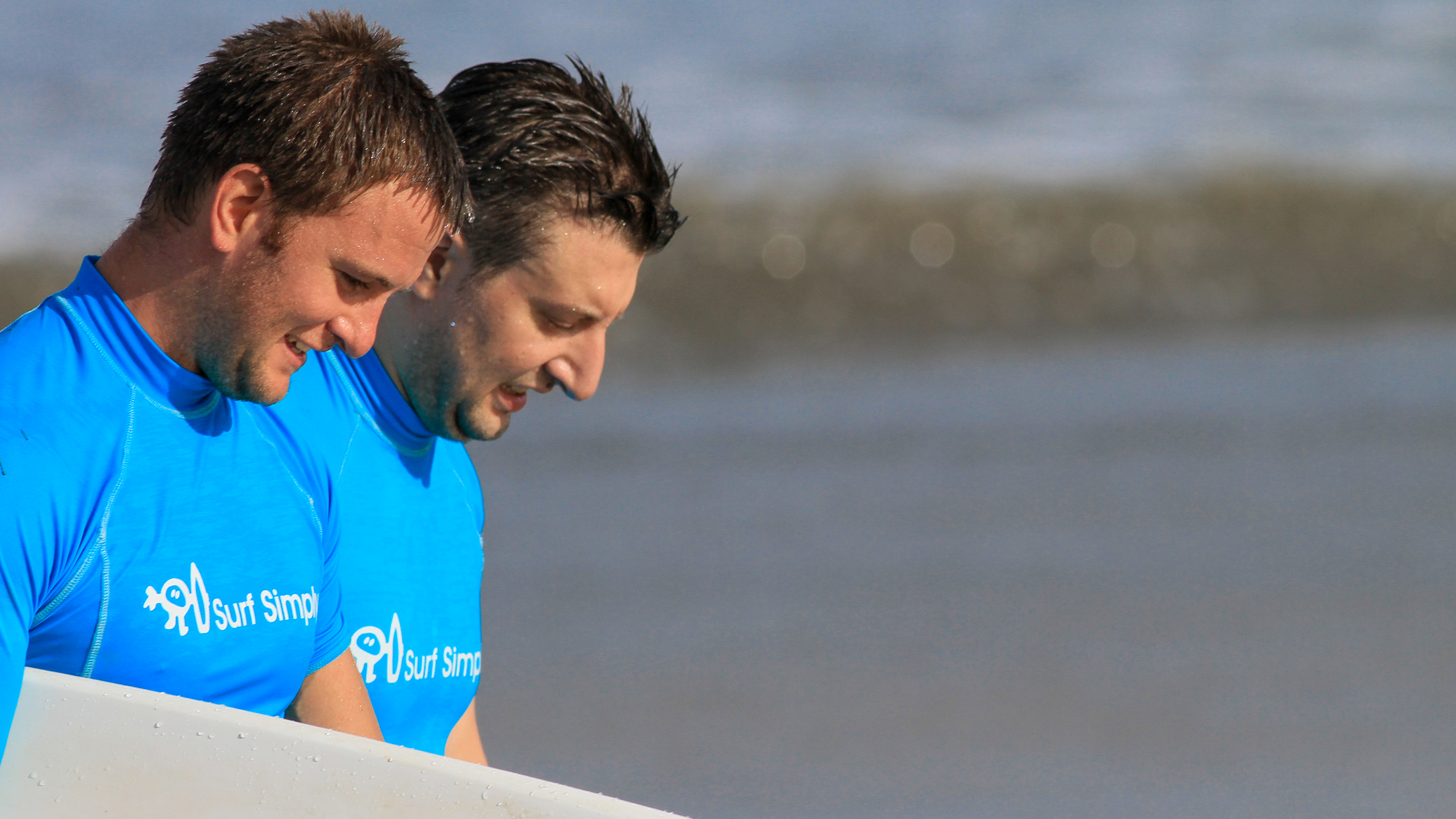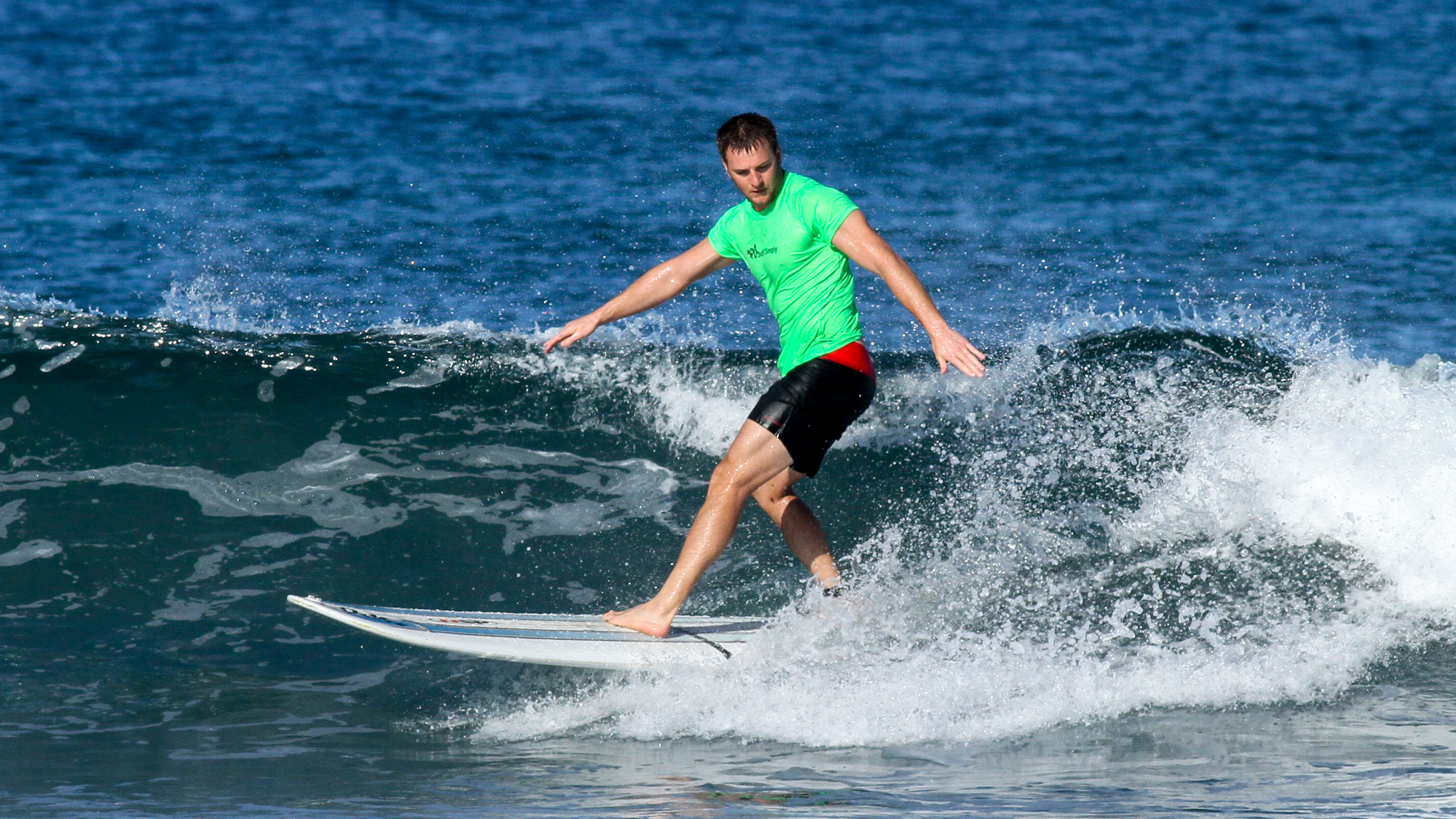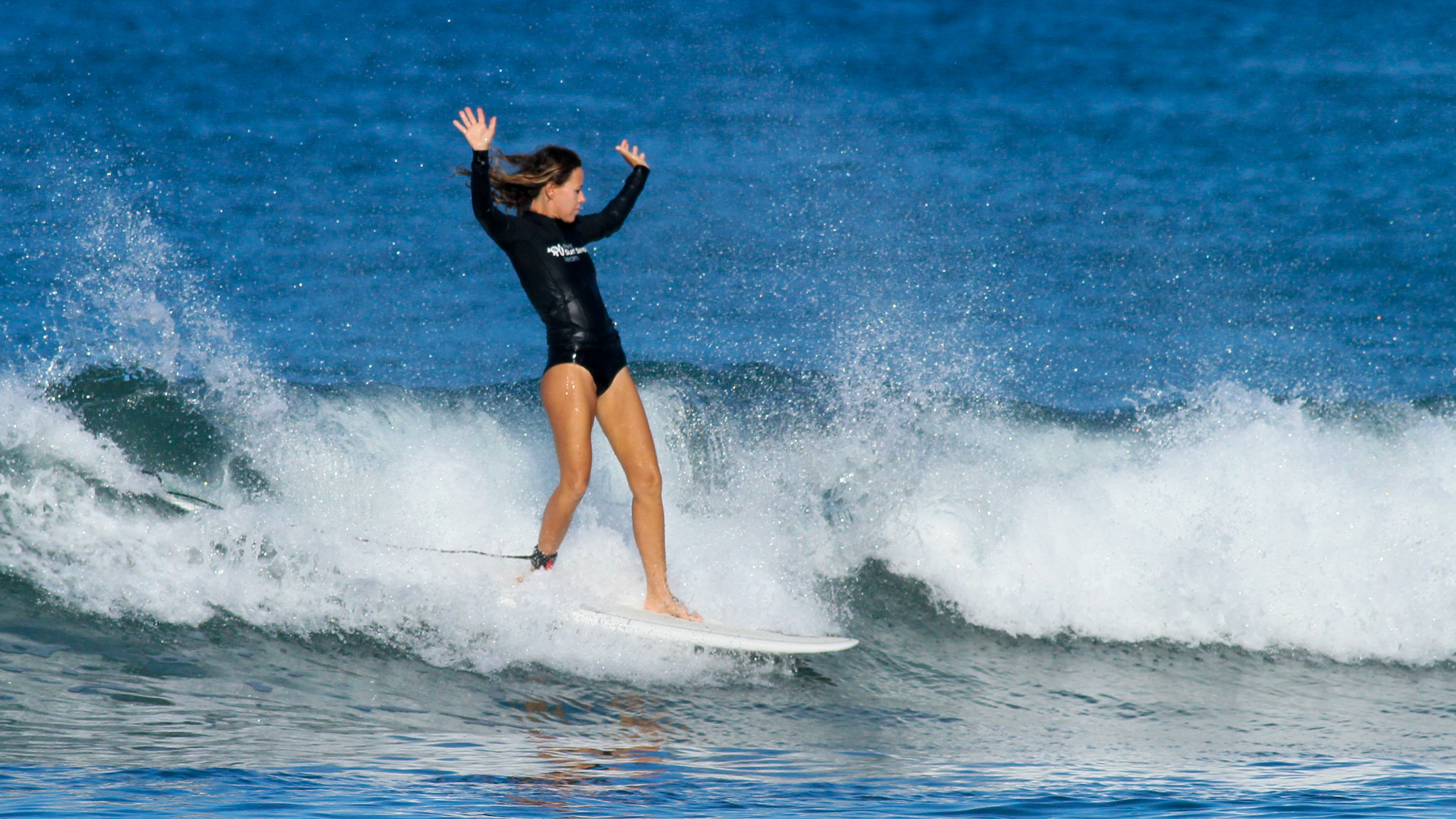July 4th, 2014, Pacific Ocean, Costa Rica
It’s early morning, and already it’s been a great day.
I’ve just ridden a massive wave, paddled back out through the surf, and am sitting on my board resting and waiting for the next one.
On his board nearby sits Ru Hill, the founder of Surf Simply, known as the best surf school in the world. He’s been my instructor all week.
As I scan the horizon for incoming waves, the sense of elation that I feel from my last wave mixes with a feeling of… I’m not quite sure. Sadness? Regret? Astonishment? Relief?
You see, in the past week I’ve learned more about surfing than I had in the previous ten years of trying. I’ve wasted a lot of time, and a lot of effort.
Surfing is a curious thing.
It’s a truly honest sport. It’s what skiing might be like if you had to hike back up the mountain for every run, if you had to work through small avalanches the whole way.
You physically pay for every rep that you get.
Once you’ve made it out past the breaking waves and are trying to catch one, you’ve got a very good chance of falling immediately and going straight back to paddling.
If you catch a wave, you’ve only got a few seconds to do something and try to get a feel for what’s going on. A beginner can spend hours in the water and only get a few seconds of total time on the board.
There is an art to each aspect of surfing.
Skill easily beats raw effort.
On most beaches you’ll see men and women in their 60s or older easily carving across waves with a calm, practiced grace while fit youngsters get beat up in the break zone.
Learning that art can be terribly frustrating.
It’s hard to even know what you’re doing wrong, let alone how to do it right. Each repetition is tough to get and lasts only a few seconds.
Feedback is minimal at best, and even the guidance from most surf coaches or well-meaning friends is exasperatingly nebulous.
“When you feel the wave, just stand up!”
“Try to balance better!”
After ten years of this, and surf trips through Mexico, New Zealand, the US and Costa Rica, I didn’t feel like I knew much more than I did when I started. I wasn’t even sure how to tell my bad habits from the good ones.
I had worked my way into surfing bigger waves, and falling a little less often, but I felt like I was just getting better at doing something poorly.
After a few days of surf school, it was obvious: Past a certain point, “just do it” isn’t enough.
Ten years of muddling through versus a week of direct and purposeful instruction showed me the difference that a good training system can make.
I got to thinking about how this process plays out in other fields.
Consider exercise and nutrition.
Trying to get into better shape, or eat healthier, is much like starting surfing.
There are waves of conflicting information hitting you from all sides. Other people seem to have “the secret” that you don’t. You fall down a lot.
You’re never sure what you should be focusing on or if you’re doing it right or wrong.
Without expert guidance and a good system, you’re going to waste a lot of time and build bad habits.
A beginner falling off a surfboard doesn’t necessarily know why it happened. Or what to do differently next time (or if they should be practicing something that keeps making them fall).
An exerciser whose back hurts after several months of workouts, or who hasn’t gotten any more fit from his last program, doesn’t necessarily know why that is either, nor what to do about it.
Someone trying to lose weight or “eat healthy” without a clear plan, feedback, or guidance may feel like they “fall down”, over and over and over, face first.
As I learned about surfing, the right approach in the gym can dramatically improve your progress, faster.
So even if you don’t love surfing, how could this apply to you?
What can you learn from the world’s best surf school?
Surf Simply’s tried-and-true core principles apply to learning anything, not just how to surf.
Whether you’re a fitness pro looking to improve the results of your clients, someone trying to get into better shape and stay that way, or even trying to learn another skill like cooking, skiing or playing a musical instrument, these principles can help you do that better.
Creating a system that builds expertise is a complex undertaking, but here are some of the main pieces to the puzzle.
- Stages of learning and getting to “good enough”
- Going past “good enough” with deliberate practice
- Developing instinct — aka “a feel for things”
- “Vaccinating” yourself against stress
The process of skill learning
Learning a skill happens along a continuum, loosely defined by three stages.
Stage 1: Slow and conscious
Think back to when you learned to type.
At first, you were in hunt-and-peck mode, going letter by letter. Learning was slow, conscious and took up almost all of your attention. You made big mistakes, often. You could only focus on one thing at a time, like finding the damn semicolon.
Stage 2: Getting a feel for it
After a while, you could start to tap out entire words and sentences at once, instead of thinking letter by letter. You got faster and more accurate. Your mistakes were fewer and smaller.
You didn’t have to think so much. Instead, you started to get a “feel” for things. When you hit the wrong letter, you could often sense it before you saw it on the screen.
Stage 3: Intuitive instinct
If you kept working on your typing, eventually you didn’t have to work at it, or even think about it. You could just do it.
Letters flowed from your fingers smoothly and you didn’t even have to look where they were. You could type while listening to music, or maybe even having a conversation.
You’re now at the magical place of “good enough”.
Why “good enough”… isn’t.
Now let’s imagine you don’t need to be a typing master. You just need to be good enough.
You’re happy there, at “reasonably decent”. Things are relatively easy.
Here’s the important thing to know: Getting better from that stage forward will take active work.
You won’t become an awesome typist by accident.
You’ll just be… OK.
The research term for “good enough” is theory of par or tolerance. It’s the level of performance that most people are content to meet, but not exceed.
And it’s almost always less than they’re actually capable of.
Now, there’s nothing bad about “good enough”.
Unless you do, in fact, want to get better.
Then, you need deliberate practice.
Deliberate practice
If you do an activity over and over, you’ll get good at it, up to a point.
Past that point, simply adding more practice won’t help. (Consider how many people are lousy drivers, even if they’ve been driving for decades.)
To get better, your practice has to be deliberate. It has to have a goal.
In surfing, that’s the difference between “just getting out on the board”, and surfing while trying to refine a specific skill, like a carving turn.
In the gym, it’s the difference between just knocking out the reps and moving on, and paying attention to something like how your spine is positioned during a squat.
Getting better means getting worse… briefly
There’s a catch to deliberate practice, though:
You have to allow yourself to suck for a while.
Because to learn past “good enough”, you have to regress back down to levels where things become more conscious again. In other words, the level where you’re not good enough any more.
A lot of our clients struggle with this. If they’ve got some knowledge about working out or “eating healthy”, it’s hard for them to regress.
“I’m already good enough,” they protest. “Give me something advanced.”
Nobody wants to feel like they’ve been knocked down to Remedial Vegetable Eating or Bench Press 101. But — apparently paradoxically — that’s where they have to go in order to become truly advanced.
Developing “instinct”
The “deliberate” part of “deliberate” practice is essential.
If we’re not paying attention to what we’re doing, don’t really know why we’re doing it, or we don’t know how well we did it, we don’t improve. Stuff is just random noise.
Conversely, when we purposely try something, observe how well it worked, adjust with awareness, and try again, we learn. We learn faster, and better.
With this conscious, goal-driven feedback loop, we get a deeper, more intuitive and wise “feel for things” rather than thinking about them.
We’re able to see differently, like a carpenter who notices when a doorframe is crooked without having to measure it. We make smarter decisions with less information, and ignore distractions.
In turn, this process of consciously developing a “feel for things” helps our brains get even better at learning new things.
Thus, experts’ instinct and ability to respond with seemingly superhuman speed and accuracy isn’t magical.
It’s simply the result of deliberate practice.
The Lego blocks of skill development
Learning is sequential. We build understanding and insight block by block, stacking one “Lego block” of learning on top of another, clicking them together to make connections.
In terms of movements, we build more complex movements out of “Lego blocks” of simpler movements, all stuck together.
When you learn a sport, you might drill each individual “Lego block”. Dribbling in basketball. Hip movement in grappling. Shuffling your feet in boxing. Serving in tennis.
In surfing, you’ll have to learn how to hold your board. How to lie on it as you paddle. Then, if you’re lucky, how to stand.
At first, it’s clumsy. The surfer’s mind is juggling foot, hip, hand, head and eye position, and learning what each of those pieces feel like.
With practice, those things become instinctive and happen more automatically.
This frees up the surfer’s mind so that they can add more pieces to the pattern, and start making the board actually do stuff.
Here’s where we often run into problems.
We get “good enough” at the basics. This frees up our brain to try new stuff. Except the “good enough” pieces are now our limiting factors.
If you’re “good enough” to just stand up on a surfboard, you’ll want to jump right away to trying other fancy things.
Except your ability to stand up is the limiting factor. It’s the Lego block that controls all the other Lego blocks.
If you never deliberately practice that basic skill of simply standing up, you’ll never get good at anything else.
This is what I did when I started surfing: I got better at surfing with a poor foundation of basic skills, and could never improve significantly no matter how hard I worked.
I wasn’t building the patterns that everything else depended on.
Likewise, our clients who resist learning the basics because “basics are boring” often find that they “fall off the wagon” when their routine changes, or the normal stresses of life hit. Their crucial “Lego block” of nutrition, exercise, and self-organization skills gets knocked out easily with even small challenges.
Stress Inoculation Training
Here’s another reason you need deliberate practice: stress.
Ever tried to do a familiar task when you were rushing and freaked out? You probably did it terribly.
Like when you were late for your important new job, and spilled coffee on yourself, and then when you tried to grab the roll of paper towels to mop it up, you knocked an entire carton of eggs on the floor with your elbow. (Your other arm, still holding the now-empty coffee mug, knocked your keys into the egg mix half a second later.)
Learning a skill can be challenging enough. Being able to recall it under stressful, real-world conditions (say, when getting knocked off a surfboard, or when your comfortable daily routine of exercise and nutrition habits gets disrupted) adds a whole new level of difficulty.
In general, stress tends to make us worse at things… unless we make stressful situations part of our deliberate practice.
We can do this with what’s called Stress Inoculation Training, or SIT.
You can think of SIT like a “stress vaccination”: a little bit of stress, released gradually and only in levels you can handle, eventually lets you deal with increasingly tough situations.
For instance, you might learn your first skills in a zero stress environment, like sitting on the beach with your surfboard. You might practice holding the board, lying on it in the right spot, and even paddling on the sand.
Then, you add a little bit of stress: You go into the water. It might be a calm, waist-deep ocean. Or it might be a pool. Just a tiny bit of stress, to start with.
Then, you add a little more stress. Maybe you go out in chest-deep water. Maybe you try a more complex skill, like diving under the waves.
Over and over, you add a little more stress, and a little more.
Eventually, of course, you’re ripping gnarly tubes during a solid swell. Or you’re staying true to your workout and nutrition habits even when your life is truly insane.
To make SIT work, you practice your skills deliberately, at a level that is just slightly challenging — you’re focused on the task at hand, but you’re almost always able to execute.
You want your mind and body to learn that a little stress is OK. All you do is change the definition of what “a little stress” is.
This is key: A vaccination is no good if it actually makes you violently ill. SIT is only effective when the student first masters their skills in a non-stressed environment. Every practice session should end in relative success.
Trying to learn a skill while practicing under increasingly stressful conditions is likely to produce failure and frustration.
We learn by making and correcting errors in deliberate practice. This can only happen if we believe that we’re capable of learning in the first place, and are willing to immerse ourselves in challenge and failure in order to become better in the future.
Coming up: What does the world’s best surf school look like?
These are the main pieces of a system designed to produce expert performance.
Next, we’ll talk about how Surf Simply puts them together into a fun experience that teaches surfing better than anywhere else in the world, and how the same principles they use can help you design excellent workouts and fitness programs.





